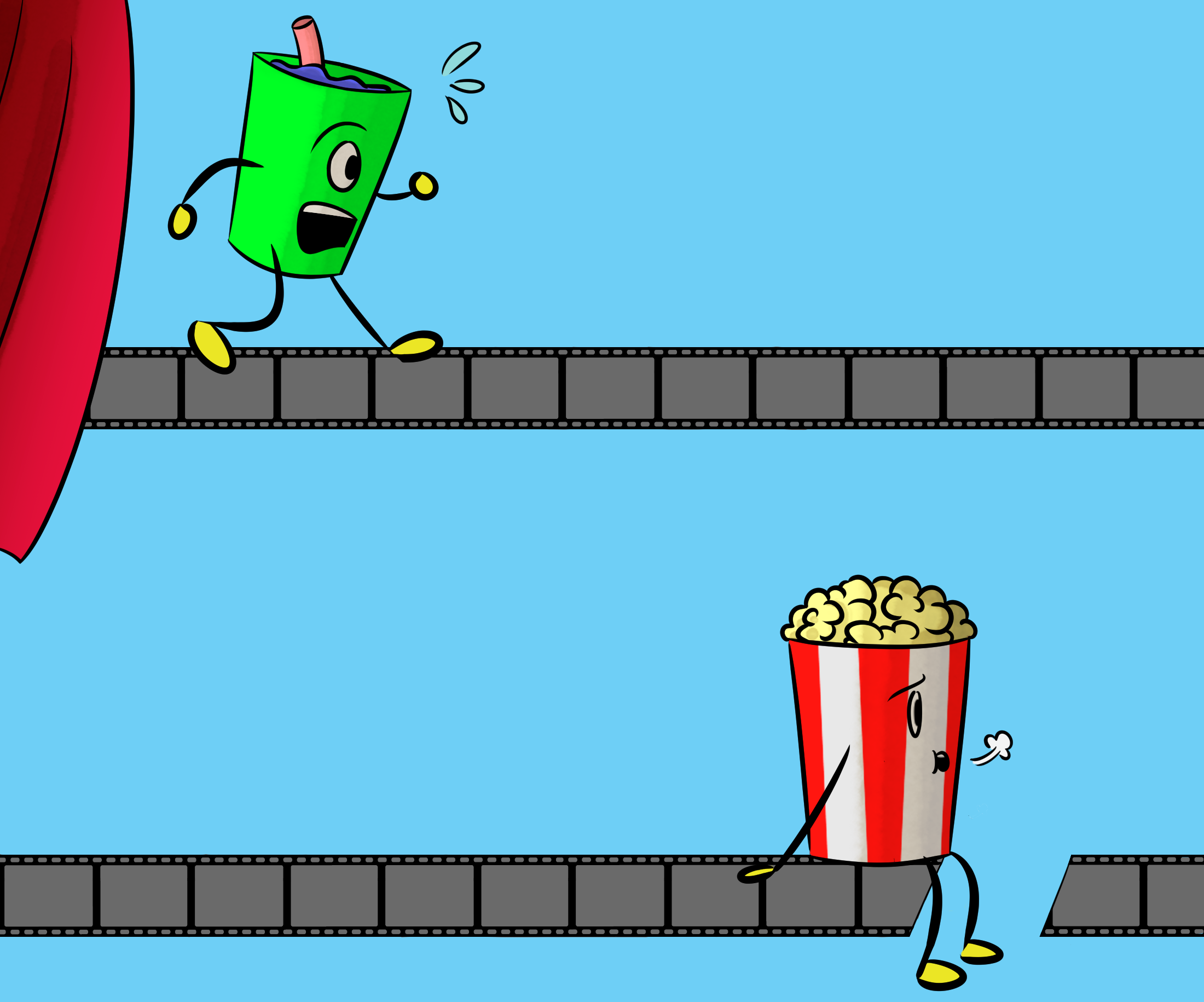So you’ve decided to go to the movies. (You probably haven’t, not when your streaming service of choice is readily available on your laptop, but for the sake of this thought experiment, let’s say you have.) You’re an hour and a half into the newest Marvel film, a terrible teen flick you love to hate, or the most recent Oscars-bound feature, and there’s one question that drifts into your mind, pushing aside all attempts to follow the plot.
How much time is left in this movie?
For whatever reason—bathroom break, popcorn refill, stiff legs, sheer boredom—you want to get up from your seat. But leave for five minutes and the plot presses forward, leaving you in the uncomfortable position of whispering to your friends upon your return: “What did I miss?”
What happened to the movie intermission? Where did they go, those 10-15 minute breaks in films when the lights would rise and you could (finally) debrief the first half with your friends? Today, when you watch an old film with a built-in intermission, it feels like a relic from an era when actors spoke with mid-Atlantic accents and the credits rolled at the start of the movie.
The intermission’s original purpose was practical. Back when movies were projected from reels of film, the intermission gave projectionists time to switch between reels without forcing the audience to sit in a dark, silent theater. After the switch to digital film, intermissions stuck around as a staple of the movie theater experience—unless you grew up in 21st-century America.
Intermissions gradually faded from American cinemas throughout the second half of the 20th century, with 1982’s Gandhi being the last major film to feature an intermission—without the intermission, Gandhi would have kept viewers in their seats for over three hours. In the U.S., intermissions were dropped from films because cinemas wanted to fit in more movie screenings in a day.
Although intermissions are still present in plays or operas, the rationale in those contexts makes more sense from a practical point of view, providing the performers a chance to take a break and the crew time to do a hefty scene change.
Quaint. Charming. Practical.
But now they’ve vanished, replaced by the ever-expanding action-packed movie length, leaving moviegoers without the built-in bathroom break or concession stand run.
When it’s so easy to stream movies from the comfort of our couches, choosing to go watch a movie on a screen tens of times larger feels like it should be a special occasion. But when we arrive, it can feel tedious, rather than rewarding. Without intermissions, moviegoers are tethered to their seats for hours, faced with a vexing dilemma: toughing it out until the end of the movie, or slipping out of the theater and missing a few (possibly crucial) minutes of the film.
But the intermission has not vanished completely. If you’ve ever been to a cinema abroad, it’s possible you’ve seen this seemingly obsolete tradition alive and well. Egypt, Iceland, Jamaica, Switzerland, and Turkey all have intermissions in their movies. In India, Bollywood filmmakers even incorporate the intermission into their film’s structure; the breaks don’t disrupt the flow of the film because they’re woven into the story. Evidently, the world has not completely moved away from the intermission. Why can’t we bring it back here? Moviegoers in intermission-friendly countries get to enjoy a break in their movies—but could bringing back the intermission have other benefits as well?
With 15-second TikToks, Instagram reels, and the infinite scroll of a dozen other social media apps, our attention spans are getting calibrated to short, quick bursts of content. As social media trims our attention spans, movies are getting paradoxically longer. Movies routinely clock in at over two hours; Business Insider found that today’s highest-grossing films are 120 percent longer than they were 30 years ago. Avatar: The Way of the Water (2022) clocked in at three hours, 12 minutes—30 minutes longer than its predecessor. We’re being presented with two extremes: a rapid, never-ending succession of short videos that study your every click to keep you tethered to the app as long as possible, or a two-plus hour film. Where’s the chance to enjoy the moment?
Enter: The intermission, a chance to take a break and enjoy the film by reflecting on what you’ve just seen and wondering what will come next.
Just as streaming some services switched to releasing TV episodes one at a time to bring back the suspense of waiting a week for the next episode, slotting in an intermission could add suspense to the movie-watching experience. Splitting the movie-watching experience gives more time for the plot to sink in and allows viewers to better appreciate the film. During an intermission, viewers can revel in what happened during the first half and speculate about what will come next, making the experience more interactive.
Going to the movies used to be much more of a social event. People lined up to see premieres, dressed up, splurged on popcorn and Skittles, and settled down to watch the film until the intermission. It was a communal experience and a well-needed break. Watching movies at the theater can still offer this, allowing friends to not only watch films in each others’ company but also engage in discussions about the plot, characters, favorite moments, and hot takes. But right now this cultural institution is dying out. Even before the pandemic, ticket sales were dropping each year, and after rebounding from 2020, ticket sales still haven’t risen to prepandemic levels. Unless something changes, the statistics on theater attendance will grow grimmer as more people opt to watch Netflix at home instead of dishing out $17 for a subpar theater experience. By bringing back the intermission, cinemas will bring back some of the movie theater charm that’s been lost.
Going to the movies is a great way to get a break from the stresses of everyday life. But sometimes even that’s not enough—sometimes, we really just need an intermission.






Brava!!!! You nailed this. Titanic was the last movie I saw where I was swearing under my breath as to why the theater couldn’t have just created an intermission for those of us with a love for Diet Coke but have small bladders. Going to a theater HAS become a second choice for most of us. And honestly – how would one manage it in this day and age? If you need the potty, you have to drag along your coat and purse because the days of people having enough morals to not riffle through your coat pockets (or take your coat altogether) are gone. Our youngsters have no work ethic so the floors are still sticky and the treats break the bank. I mean really – $30 for a bucket of popcorn and 2 fountain sodas? I think the last movie I saw in the theater was the original Spider-Man III where I spent the last 1/3 or the movie tending to a parent-less, 90 pound 12 year old who drank enough vodka to kill an elephant who vomited on my husband and we had to take her into the lobby and keep her upright til the paramedics came. Theater manager? He stood at a distance, gave us some free movie tickets and us barf soaked parents went home – not knowing if Spider-Man went to the dark side or not.
Theaters would have to make some radical changes to get most people back into those seats. I don’t have a plan because I can’t think of anything they could do to get people in the door and make money (increasing the pricetags on those already overwhelming concessions won’t save them). When a new movie comes out, I can wait til I stream it – even if it’s still in its ‘buy only’ stage for $25. It’s already cheaper than the crusty theater, I can pause, grab dinner, make that bathroom break and not miss a thing.
HOW DOES A MOVIE THEATER COMPETE WITH THAT??? Not to mention all the garbage they’ve been dumping out in the past 5-10 years. I think we need a drive-in theater that is run by Uber Eats and you order your pleasure, have it delivered to your car and enjoy – unless you’re in Minnesota and it’s -10°.
I absolutely love going to the theater to see movies and am disgusted by the fact that there is no intermission. So often I’ve sat in the theater alone, or just me and the person I came with, enjoying a private showing of whatever film is playing.
And while it’s a fun experience, it’s also fun to experience a great film in a mass of people who are laughing or crying along with me. Having lived in Istanbul for a short year, I got spoiled seeing movies and knowing there was an intermission coming up ~ your take on how it allows the audience to ponder what they’ve experienced and anticipate what’s next is so accurate!
I believe that movie theaters may see an influx of patrons if they added intermissions and LOWERED concession prices to make them more affordable. Everyone wants some kind of snack while watching a movie, even if it’s just a bottle of water, but due to the cost many people either try to sneak things in or just go without.
Thank you for your wonderful article!
* Last movie viewed at the theater: Furiosa/Mad Max. Before that, Planet of the Apes/ Kingdom, and prior to that was Godzilla X King Kong (in 3D).